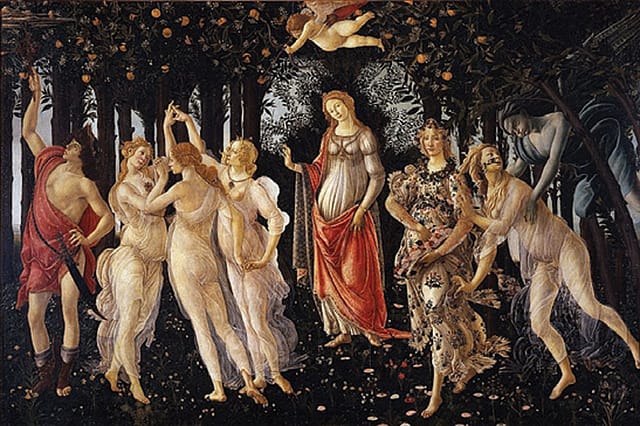Why Blame Botticelli?

"WHEN THERE'S NO food, what use is art? When there's no water, what use is art?" shouted a pair of anti-fossil fuel eco-ninjas who had glued themselves to the frame of The Hay Wain a few weeks ago at the London National Gallery. The painting is an invaluable masterpiece romanticising the pastoral idyllic by the great landscape artist John Constable.
The duo are among a growing number of environmental activists who have taken to gluing themselves to masterpieces displayed in some of the world's most visited museums.
Lately, the delicate countenances of a priceless Picasso in Melbourne; a Botticelli in Florence; a Rubens in Munich; a Vermeer in the Hague; and a Van Gogh in London have been imperilled by this tribe of agitators. The stated objective is to vandalise these iconic canvasses to conjure images of "unethical" dealmaking between oil companies and national governments. So why art, many ask. Why haven't the activists glued themselves to the front of polluting public transport vehicles? Surely, that would be a more apt analogy to draw? Those who speak up in defence of the desecrators take pains to distinguish the perpetrators of these artful terrors from your garden variety headline hunters. They point out that through their chosen method of creative destruction, John Constable's "painting becomes more than some escapist countryside fantasy—it becomes a poignant reminder that the natural landscape is endangered." This is perhaps also precisely why protestors menaced Sandro Botticelli's Primavera. Climate change brought on by carbon emissions will turn Earth into a sterile wasteland in total contrast to the fecund sylvan paradise that springs forth from Botticelli's canvas.
The vandalism of the "Just Stop Oil" activists has thus served to force us to ponder their questions: "When there's no food, what use is art? When there's no water, what use is art?"
But for all those who militate righteously against exploitative capitalism, here's a point to ponder. The reason that the climate activists got within touching distance of humanity's most treasured heritage in the first place is because of the unstated trust between the state's institutions and the public. It is easy to forget that the openness and accessibility of democracy that we take for granted are just as fragile as the elements of the biosphere that we seek to preserve. If the means of protest undermine the terms of the social contract, we should expect an erosion of trust. The actions of the few will have consequences for the vast majority that may find their freedoms curbed by security checks, erecting of barricades and cordon sanitaire. Civil disobedience is a legitimate tool of dissent employed by activists. Mahatma Gandhi's blockades worked and won approval over the public even though their businesses were heavily impacted only because Indians under the British knew that they had no other means to protest the draconian and arbitrary impositions of their colonial masters.
2026 New Year Issue
Essays by Shashi Tharoor, Sumana Roy, Ram Madhav, Swapan Dasgupta, Carlo Pizzati, Manjari Chaturvedi, TCA Raghavan, Vinita Dawra Nangia, Rami Niranjan Desai, Shylashri Shankar, Roderick Matthews, Suvir Saran
But times have changed. The mode and manner of dissent against colonial rule cannot be equated with dissent in a self-ruled democracy. In most democracies around the world, the state and the public accept that protests will be designed to cause a degree of inconvenience. But at the same time, there is also depleting appetite for protests that inflict too great a cost on the public.
Indeed, Extinction Rebellion eco-warriors, Million Maskers, MAGA stormtroopers, Bajrang Dals, Kranti Senas, Ram Senas and even the "dadis" of Shaheen Bagh have recourse to avenues other than occupying public spaces, storming Congress, vandalising public property or defacing a nation's heritage.
In the world's oldest democracy, the January 6, 2021 siege and subsequent storming of the US Capitol threaten to increase the gap between the US government and the vast majority of Americans. Now, there's much debate on the merits of a Bill being mooted to erect a permanent fence around the Capitol building. Here, in the world's largest democracy, the Supreme Court has repeatedly expressed derision over the blockades mounted by a cast of protesters across the country and, especially, in the context of the agitation over the CAA legislation. The Supreme Court ruled that the "right to protest cannot be anytime and everywhere. There may be some spontaneous protests but in a case of prolonged dissent, there cannot be continued occupation of public spaces affecting the right of others." The unfortunate consequence of the Supreme Court judgment is that it is now being indiscriminately quoted by authorities to deny permission to civil rights groups to demonstrate against the state. In fact, there is today a permanent injunction on protesting atop Raisina Hill, the once cherished soap-box of India's democracy. A small number of citizens have ruined it for the greater number.
Perhaps more than climate change, Just Stop Oil activists may have inadvertently given us all cause to ponder the more immediate question: Is the abuse of liberty only harming democracy by endangering liberty?
